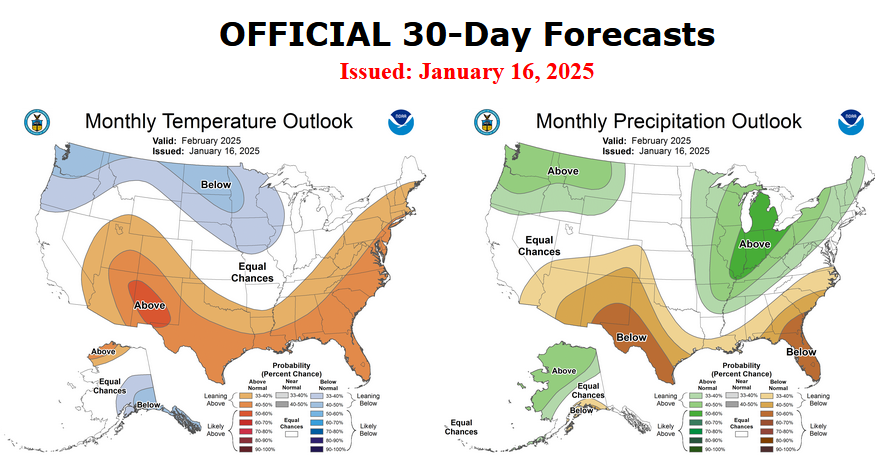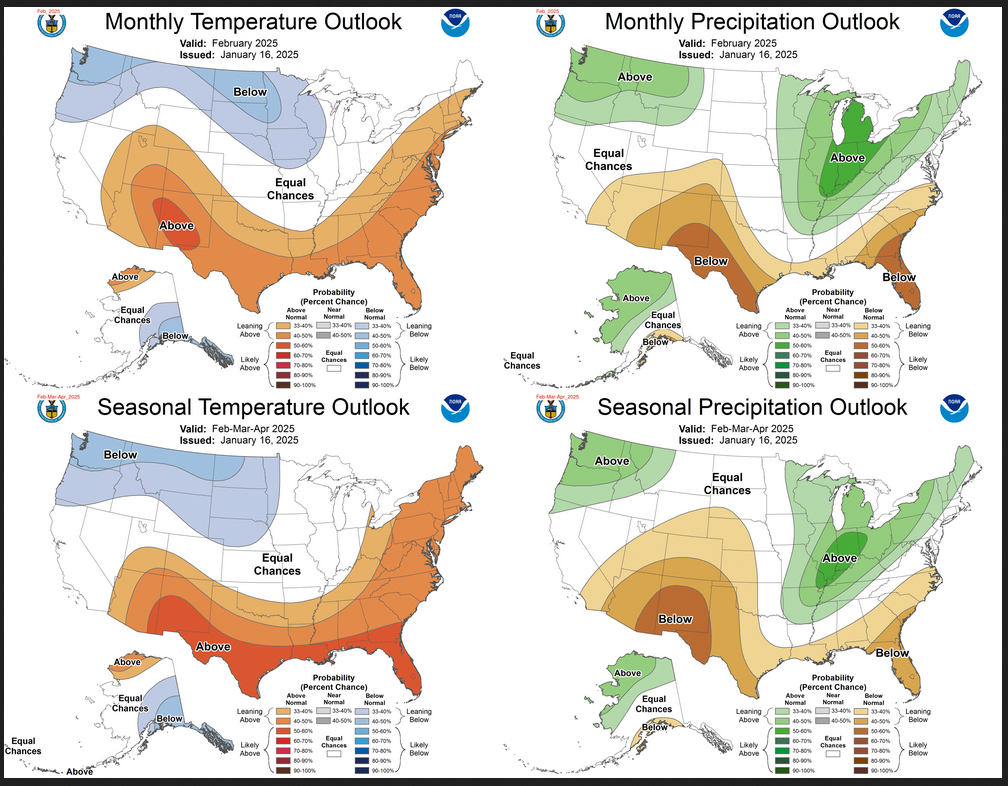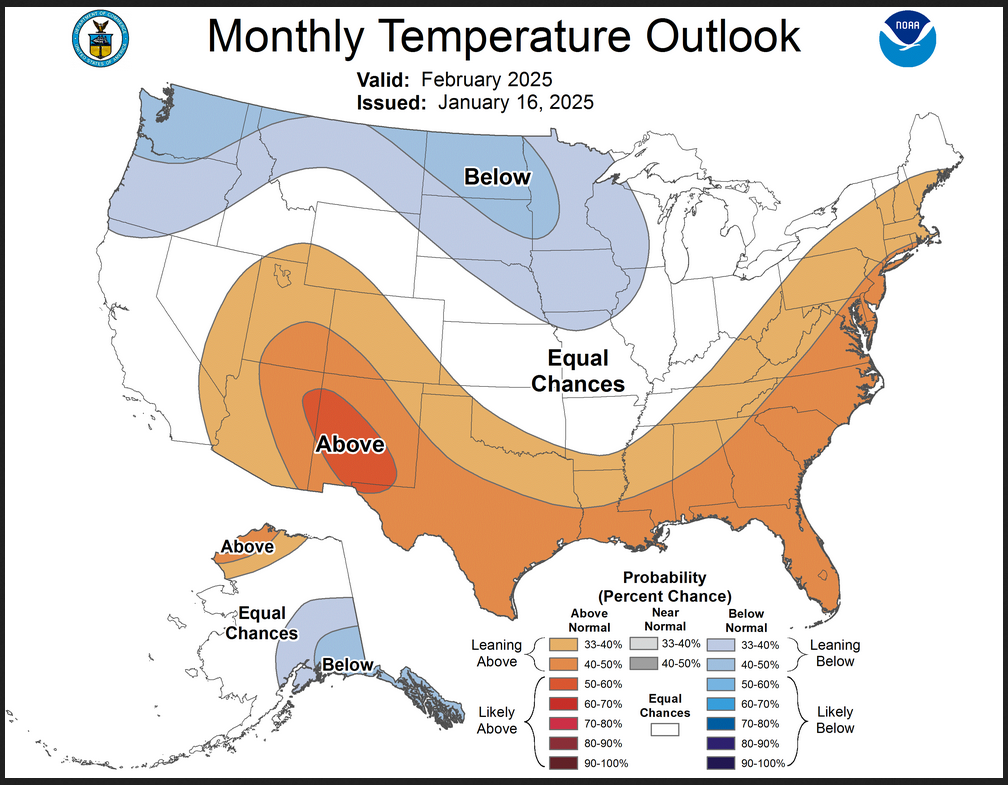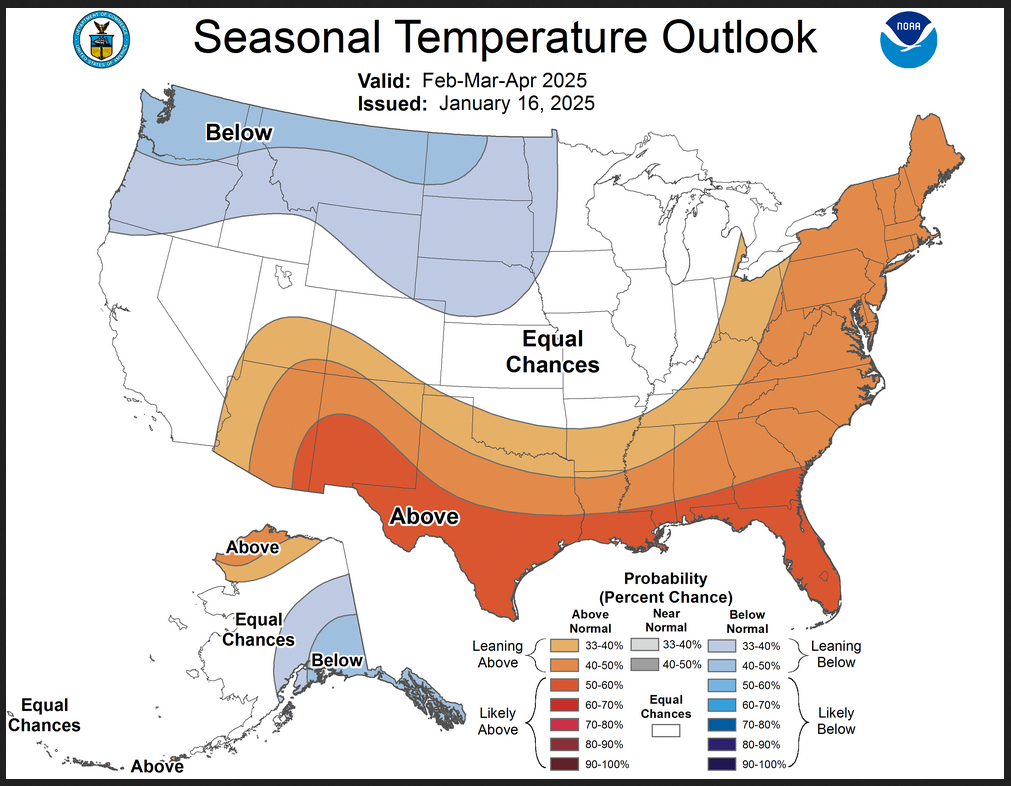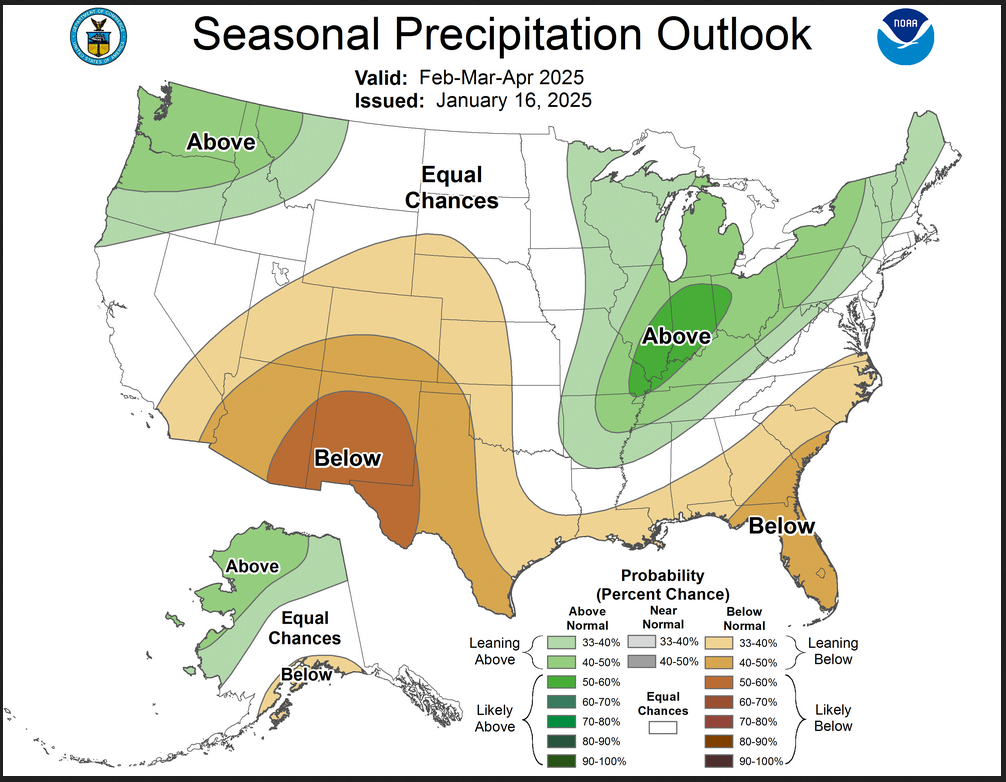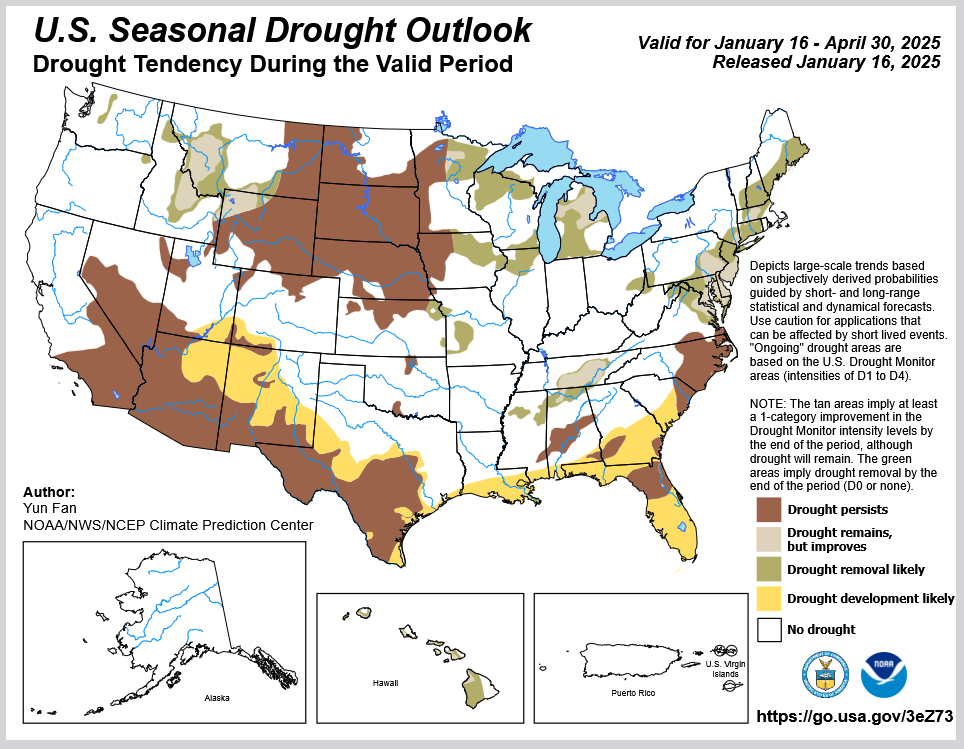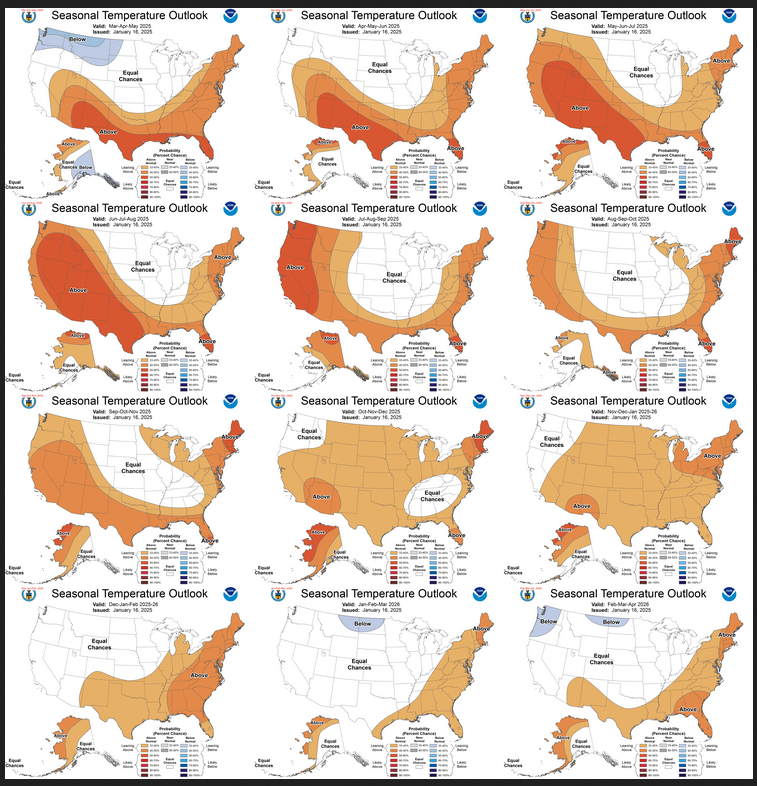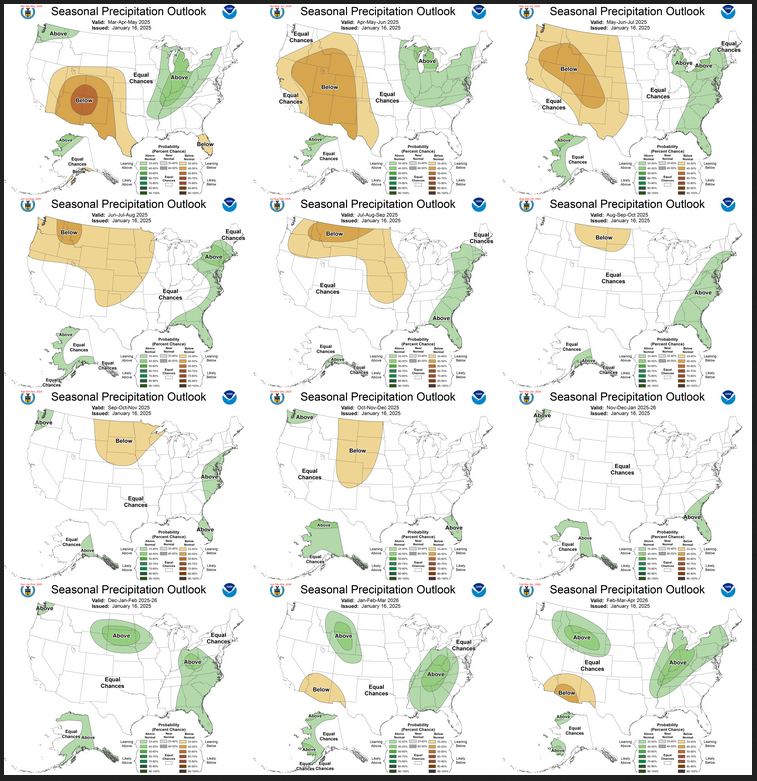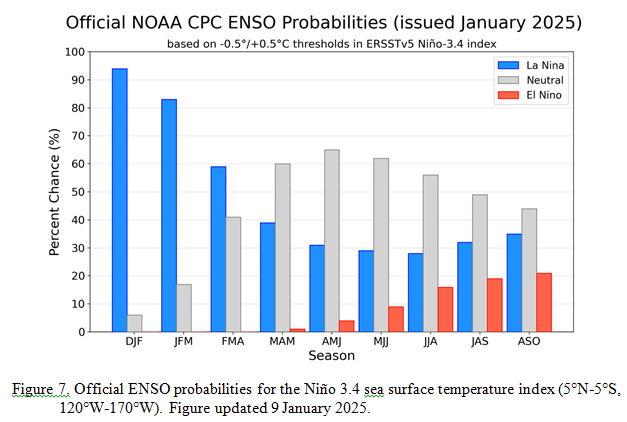By Sig Silber

On the third Thursday of the month right on schedule NOAA issued their updated Seasonal Outlook which I describe as their Four-Season Outlook because it extends a bit more than one year into the future. The information released also included the Mid-Month Outlook for the following month plus the weather and drought outlook for the next three months. I present the information issued by NOAA and try to add context to it. It is quite a challenge for NOAA to address the subsequent month, the subsequent three-month period as well as the twelve successive three-month periods for a year or a bit more.
We are now experiencing La Nina conditions. The strength of the La Nina may be fairly weak and the la Nina is expected to last for only a few months. The transition from La Nina back to ENSO Neutral will be complicated.
From the NOAA discussion:
“The most recent El Niño Southern Oscillation (ENSO) discussion has now stated that we are under a La Niña Advisory and that La Niña conditions are present.” “La Niña conditions are expected to persist through February-April (FMA) 2025 with a 59% chance, with a 60% chance of a transition to ENSO-neutral during March-May (MAM) 2025. This La Niña is predicted to be weak, with the majority of guidance favoring SSTs in the Niño3.4 region around -0.5 degrees Celsius. Conversely, chances of a strong La Niña are near zero. Though we still expect the canonical La Niña impacts in the upcoming few seasons, there may be more variability within the season given the forecasted weakness of the event.“
It will be updated on the last day of January.
Then we look at a graphic showing the next month and the next three months.
The top row is what is now called the Mid-Month Outlook for next month which will be updated at the end of this month. There is a temperature map and a precipitation map. The second row is a three-month outlook that includes next month. I think the outlook maps are self-explanatory. What is important to remember is that they show deviations from the current definition of normal which is the period 1991 through 2020. So this is not a forecast of the absolute value of temperature or precipitation but the change from what is defined as normal or to use the technical term “climatology”.
| Notice that the Outlook for next month and the three-month Outlook are fairly similar. This tells us that March and April will be substantially the same as February for most of CONUS. Part of the explanation for this is that NOAA expects La Nina to impact all three months. |
The full NOAA Seasonal Outlook extends through February/March/April of 2026 (yes that is more than a year out). All of these maps are in the body of the article. Large maps are provided for February and the three-month period February/March/April. Small maps are provided beyond that through February/March/April of 2026 with a link to get larger versions of these maps. NOAA provides a discussion to support the maps. It is included in the body of this article.
In some cases, one will need to click on “read more” to read the full article. For those on my email list where I have sent the url of the article, that will not be necessary.
The maps are pretty clear in terms of the outlook.
And here are large versions of the three-month FMA 2025 Outlooks
First temperature followed by precipitation.
| These maps are larger versions of what was shown earlier. This is a pretty definitive pattern. |
NOAA Discussion
Maps tell a story but to really understand what is going you need to read the discussion. I combine the 30-day discussion with the long-term discussion and rearrange it a bit and add a few additional titles (where they are not all caps the titles are my additions). Readers may also wish to take a look at the article we published last week on the NOAA ENSO forecast. That can be accessed HERE.
I will use bold type to highlight some especially important things. All section headings are in bold type; my comments, if any, are enclosed in brackets [ ].
CURRENT ATMOSPHERIC AND OCEANIC CONDITIONS
La Niña conditions recently emerged, with below-average SSTs observed across the central and east-central Pacific ocean, above-normal SSTs in the western Pacific, and near-normal SSTs in the eastern Pacific. The latest weekly Niño indices ranged from 0.3 degrees Celsius in the Niño 1+2 region, and -0.7 degrees Celsius in the Niño 3.4 and 4 regions. The below normal SSTs have persisted in the central and east-central equatorial Pacific Ocean for at least the last 4 weeks. Negative subsurface temperature anomalies reached a minimum in late December, but have persisted overall since, and recently expanded to the central Pacific Ocean. Over the past 30 days, low-level wind anomalies were easterly from the western to central equatorial Pacific Ocean, and upper-level wind anomalies were westerly across the east-central and eastern equatorial Pacific Ocean. Finally, convection has been suppressed near the Date Line with enhanced convection over Indonesia. These collectively reflect a La Niña, and as such, a La Niña advisory is now in effect.
The Madden-Julian Oscillation (MJO) became incoherent during early January, but more recent observations of the Realtime Multivariate MJO (RMM) index show a regain in amplitude over the Western Hemisphere, with the MJO slow to resume its eastward propagation. However, for the upcoming forecast period over the next few weeks, dynamical models are unanimous in favoring a high amplitude MJO event propagating from the Western Hemisphere and across the Indian Ocean. Though perhaps more relevant to the monthly forecast, the forecasted MJO may constructively interfere with the emerging low frequency base state, potentially strengthening the La Niña conditions later this winter.
PROGNOSTIC DISCUSSION OF SST FORECASTS
The dynamical models in the Columbia Climate School International Research Institute for Climate and Society (IRI) plume continue to predict a weak and a short duration La Niña. La Niña conditions are expected to persist through FMA 2025 with a 59% chance, transitioning to ENSO-neutral likely during MAM 2025 with a 60% chance. Dynamical models predict a weak La Niña, with the Niño3.4 index less than -0.5 degrees Celsius. The above mentioned MJO may add some uncertainty to the strength of the La Niña later in the winter if there is constructive interference, though we still expect the La Niña to be on the weaker side.
30-DAY OUTLOOK DISCUSSION FOR FEBRUARY 2025
The long-awaited transition from a neutral El Niño Southern Oscillation (ENSO) to a weak La Niña finally occurred during December 2024, with the latest weekly value of the Oceanic Niño Index (ONI) of -0.7C for the Niño 3.4 region. Below-average sea-surface temperatures (SSTs) now dominate the central and east-central Pacific with significant subsurface cooling to a depth of 100-200 meters. Broad expanses of enhanced (suppressed) tropical convection are noted over the vicinity of Indonesia (Date Line), with persistently enhanced low-level trade winds over the western and central near-equatorial Pacific. La Niña conditions are expected to persist through the Feb-Mar-Apr (FMA) 2025 season with odds of 59 percent, followed by a nearly equally likely transition to ENSO-neutral starting in Mar-Apr-May (MAM) 2025.
In addition to La Niña being the expected primary driver of the atmospheric circulation pattern in February, there is significant forcing associated with the Arctic Oscillation (AO) and the Madden-Julian Oscillation (MJO). The AO index has been negative during the past two weeks, which has likely contributed to the current cold snap across the central and eastern contiguous U.S. (CONUS). The AO index is forecast to transition toward its positive phase in the next 2 weeks, which may signify at least a brief reprieve from the persistent influence of Arctic air masses over this portion of the country. In the tropics, the convectively enhanced phase of the MJO is currently in the Western Hemisphere, near the interface of Realtime Multivariate MJO (RMM) Phases 8 and 1. During the past 10-14 days, there has been a very significant increase in amplitude of the MJO signal, though there has been little eastward propagation. Most RMM-based MJO Index forecasts predict a high-amplitude MJO accelerating to phase speeds more consistent of a convectively-coupled Kelvin Wave, as the signal traverses the remainder of the Western Hemisphere, Africa, the Indian Ocean, and reaches the Maritime Continent during the next two-week period. Historically, an MJO signal propagating eastward across the Indian Ocean and Maritime Continent favors a warm response downstream over the central and eastern CONUS towards the end of January, but this is contradicted by most dynamical model guidance which favors the continuation of below normal temperatures across this region.
Other considerations for the February outlooks include coastal SSTs, sea and lake ice, and snow cover. At the present time, near to primarily above normal SSTs prevail near the West Coast of the CONUS, the western and central Gulf Coast, and near the southwest coast of Alaska. Below normal SSTs are observed near the coast of the Northeast CONUS. Most of the Alaska coast as far south as Kuskokwim Bay (Southwest Alaska) is dominated by sea ice. Over the Lower 48 states, the Great Lakes remain mostly ice-free as of mid-January, with relatively shallow Lake Erie being the most likely to freeze over during the next few weeks. Current snow cover is widespread across the northern and central CONUS, with associated radiational cooling helping to keep surface temperatures lower over this area.
The monthly Temperature and Precipitation Outlooks for February are based on historical La Niña composites and regressions and the secondary forcings described above, as well as on dynamical and statistical model support. Dynamical support is derived from dynamical model suites including the North American Multi-Model Ensemble (NMME), Copernicus Climate Suite (C3S), and from the Climate Forecast System version 2 (CFSv2) dynamical model. Statistical support comes largely from a combined ENSO-OCN tool, and to a lesser degree the Canonical Correlation Analysis (CCA). CPC’s official outlooks for Weeks 3-4, and monthly and submonthly temperature and precipitation guidance from the Global Ensemble Forecast System (GEFS), CFSv2, and European Centre for Medium-Range Weather Forecasts (ECMWF) models are also used in the preparation of the February Outlooks, though it is important to note that these forecasts only cover the first half of February.
Temperature
The February 2025 Temperature Outlook features elevated odds of above normal temperatures over the vicinity of the Four Corners states/Southwest, southern Plains, Lower Mississippi and Tennessee Valleys, the Southeast, Upper Ohio Valley, most of the Appalachians, Mid-Atlantic, and Northeast. Probabilities of above normal temperatures reach 50 to 60 percent over parts of the southern Rockies. This broad pattern is characteristic of part of the typical cold season La Niña signature, and is supported by available models and tools such as the dynamical consolidation (NMME CON), NMME Probability Anomaly Correlated (PAC) calibrated forecasts, C3S, and recent runs of the CFSv2. Below normal temperature chances are enhanced from the Pacific Northwest eastward across much of Montana, the Northern and Central Plains, and the Upper Mississippi Valley. This is supported by the statistical consolidation (Stat CON), recent runs of the CFSv2, the ENSO-OCN tool which combines influences of ENSO and trends, and the ECMWF and Deutscher Wetterdienst (DWD, German model) which are constituents of the Copernicus model Suite (C3S). Other constituents such as the United Kingdom Met Office (UKMO) and Meteo-France models appear to be too warm overall. This broad area of favored anomalous cold is also very typical of classic wintertime La Niña events. In Alaska, many tools support some variation on the classic La Niña theme which is characterized by increased chances for below normal mean temperatures across southcentral and southeast Alaska, and increased chances for above normal mean temperatures confined to northwest portions of the Mainland.
Precipitation
The February 2025 Precipitation Outlook features elevated odds for above normal precipitation from the Pacific Northwest eastward across the Northern Intermountain region and Northern Rockies to the northern High Plains. This is generally associated with the Pacific jet stream as it traverses much of the northern CONUS. One of the few dissenting opinions comes from the Stat CON (specifically the CCA input) which favors below normal precipitation across the Pacific Northwest and was discounted for this particular forecast. Above normal precipitation chances are also increased for much of the Mississippi Valley, Tennessee and Ohio Valleys, Great Lakes region, central and northern Appalachians, and interior portions of the Mid-Atlantic and Northeast. Probabilities of above normal precipitation reach 50 to 60 percent percent from the central Great Lakes region southwestward towards the Missouri Bootheel. This second region of favored anomalous storminess is associated with a typical meandering of the jetstream across this region and the resulting mean storm track, and is consistent with many of the precipitation tools. Approximately half of the available tools forecast above normal precipitation reaching the Northeast and Mid-Atlantic coasts, and while this is certainly reasonable with individual cyclonic systems, the La Niña storm track on average tends to be shifted farther inland. There are enhanced odds of below normal precipitation from far southern California generally eastward across much of the Four Corners region, the central and southern High Plains, much of Texas, far southern Mississippi Valley, and a large portion of the Southeast as far north as the Tidewater area of southeastern Virginia. Probabilities reach 50 to 60 percent over the vicinity of the Rio Grande Valley, and also most of Florida, southeastern Georgia, and nearby parts of South Carolina. This broad region of favored drier than normal conditions is consistent with the typical La Niña footprint, and is well supported by many tools, such as the Stat and NMME CONs and the CFSv2 to name a few. Over Alaska, above normal precipitation chances are elevated over most of the Mainland north of the Alaska Range, with a sliver of slightly enhanced below normal precipitation chances over parts of southcentral and southeastern Mainland Alaska. These predicted anomalies are generally consistent with mean surface high pressure and mid-level ridging over the Gulf of Alaska during La Niña events.
SUMMARY OF THE OUTLOOK FOR NON-TECHNICAL USERS (With a focus on February through April)
The most recent El Niño Southern Oscillation (ENSO) discussion has now stated that we are under a La Niña Advisory and that La Niña conditions are present. Equatorial sea surface temperatures (SSTs) are below-average in the central and east-central Pacific Ocean, with SST departures in the Niño3.4 region reaching -0.7 degrees Celsius in the past week. La Niña conditions are expected to persist through February-April (FMA) 2025 with a 59% chance, with a 60% chance of a transition to ENSO-neutral during March-May (MAM) 2025. This La Niña is predicted to be weak, with the majority of guidance favoring SSTs in the Niño3.4 region around -0.5 degrees Celsius. Conversely, chances of a strong La Niña are near zero. Though we still expect the canonical La Niña impacts in the upcoming few seasons, there may be more variability within the season given the forecasted weakness of the event.
Temperature
The FMA 2025 Temperature Outlook remains very similar to last month, and favors below normal temperatures stretching from the northwestern Contiguous United States (CONUS) to the Northern Plains, as well as southeastern Alaska. Above normal temperatures are forecast over the southern tier of the CONUS and along the East Coast into New England, and over northern Alaska. The highest probabilities of above normal temperatures reach 50 to 60% over parts of the Southwest, southern Texas, the southern Gulf States, and Florida.
Precipitation
The FMA Precipitation Outlook is similar in pattern to last month, which was and is a pattern that is canonical of La Niña in FMA. Above normal precipitation is favored over the Northwest, the Great Lakes, Ohio Valley, parts of the Upper and Middle Mississippi Valley, Interior Northeast, and western and northern Alaska. Below normal precipitation is indicated over the Southwest, Central Plains, the Gulf Coast, and southern Mid-Atlantic. Though similar to last month, probabilities are increased over the Southwest and Ohio Valley regions where we typically see strong La Niña teleconnections now that La Niña conditions are present. Equal Chances (EC) of above, near, and below normal temperatures or precipitation are indicated where there is model and/or tool disagreement, forecast probabilities for each category are similar, and temperatures or precipitation are expected to be close to the climatological distribution.
BASIS AND SUMMARY OF THE CURRENT LONG-LEAD OUTLOOKS
Note: For Graphical Displays of the Forecast Tools Discussed Below See:
http://www.cpc.ncep.noaa.gov/products/predictions/90day/tools/briefing
PROGNOSTIC TOOLS USED FOR U.S. TEMPERATURE AND PRECIPITATION OUTLOOKS
Dynamical model forecasts from the North American Multi-Model Ensemble (NMME), the Coupled Forecast System Model Version 2 (CFSv2), and the Copernicus (C3S) multi-model ensemble system were used extensively for the first six leads when they are available, as was the objective, historical skill weighted consolidation and Calibration, Bridging, and Merging (CBaM) guidance, that combines both dynamical and statistical forecast information. Additionally, La Niña conditions emerged and the official ENSO forecast favors a weak La Niña through FMA 2025. This anticipated weak La Niña signal played a role in the construction of these outlooks. Composites derived from nearest neighbor statistical analysis of recently observed tropical Pacific SST and Equatorial heat anomalies were utilized where appropriate. At later leads, decadal trends in temperature and precipitation were increasingly relied uponin creating the seasonal outlooks.
PROGNOSTIC DISCUSSION OF OUTLOOKS – FMA 2025 TO FMA 2026
TEMPERATURE
The FMA 2025 Temperature Outlook is very similar to the lead 2 prediction of FMA 2025 released in December 2024. Models remained in agreement on the overall forecasted pattern of temperature, and given the now emergent La Niña conditions, reflect a La Niña pattern in temperature. Above-normal temperatures are favored for much of the southern CONUS and East Coast, while below normal temperatures are forecast for the Northwest to the Northern Plains. Over Alaska, below normal temperatures are indicated for the Southeast, transitioning to above normal temperatures over the Northwest. The above normal temperatures over northern Alaska, the Southwest, and East Coast are further supported by above normal trends . Overall, this pattern is canonical of La Niña during FMA, though we note that with a weak La Niña we may see periods of variability within the season. EC, due to weak or conflicting signals among tools, is forecast for much of California, parts of the Great Basin, the Central Rockies and Plains, the western Great Lakes, and central and southwestern Alaska.
Though the La Niña is forecast to weaken throughout MAM 2025, there are likely to be lagged impacts of the La Niña lasting through at least the season. In addition, despite the teleconnection typically weakening in MAM vs. FMA, we still expect some lasting impacts in key regions for La Niña impacts. As such, the MAM forecast also resembles a typical La Niña pattern, and changes are not significant from last month’s prediction to this month. Below normal temperatures are maintained over southeastern Alaska, and the Northwest to the Northern Plains, while above normal temperatures stretch from the Southwest across the southern tier of the CONUS and up the East Coast, as well as northern Alaska.
Following MAM and shifting into April-June (AMJ) 2025, impacts of La Niña begin to wane as ENSO neutral conditions are forecast to prevail. Below normal temperatures over Alaska and the Northwest into the Plains diminish in favor of EC along much of the northern tier of the CONUS and southeastern Alaska. Above normal temperatures are maintained and expanded over parts of the Western CONUS, Southeast, along the Eastern quarter of the CONUS, and western and northern Alaska given model agreement among NMME and C3S. This pattern is generally maintained through September-November (SON) 2025 with the support of dynamical climate models and decadal trends . However, July-September (JAS) through SON feature larger areas of EC over the central CONUS and parts of Alaska where guidance had weak or conflicting signals . October-December (OND) 2025 and November-January (NDJ) 2025-2026 feature slightly above normal temperatures across much of the CONUS and Alaska given recent decadal trends. The above normal temperatures diminish and shift to the East Coast by December-February (DJF) 2025-2026, with some indication of above normal temperatures over the Southwest in FMA 2026, and a slight tilt toward below normal over parts of the Northern Plains and Northwest in January-March (JFM) 2026. The last 3 leads of this forecast have large areas of EC given comparatively lower confidence at these longer lead times.
PRECIPITATION
The FMA 2025 Precipitation Outlook is very typical of the La Niña teleconnection over the CONUS. Above normal precipitation is favored over the Northwest, Great Lakes, Ohio Valley, Upper and Middle Mississippi Valley, interior Northeast, and northern and western Alaska. Below normal precipitation is indicated for the Southwest, Central and Southern Plains, the Gulf Coast, the southern East Coast, and southern Alaska. This precipitation pattern is very similar to last month’s FMA forecast, however, probabilities are increased over the Southwest and Ohio Valley regions given good agreement among tools as well as the La Niña. EC is indicated over much of California, excepting the slight tilt toward above normal (below normal) precipitation over the northern (southern) part of the state, as well as the Northern Plains and coastal Northeast. La Niña typically leads to a wetter northern California and drier southern California, however, the impacts of La Niña can generally be quite variable over central parts of the West Coast. In addition, the weakness of this event may add additional uncertainty to the precipitation pattern, as such, probabilities are weak and EC is indicated over much of California. Models had some disagreement over the Northern Plains, with some tilting more wet and others toward near-normal, thus EC is favored over the Northern Plains as well. While La Niña typically can lead to below normal precipitation over the east coast, the location of the stormtrack over the Lakes and interior Mid-Atlantic during a La Niña can be variable. Should it shift more to the east, there may be more precipitation over the east coast, while shifting more to the west may lead to less precipitation. Given the weakness of the La Niña leading to potentially more variability in the teleconnection pattern vs. during a strong La Niña, EC is favored over the Northeastern coast. Similarly to temperature, we expect some lagged impacts of the La Niña into MAM 2025, and the forecasted precipitation pattern remains similar into this season. As the forecast progresses through later leads and into Fall/Winter 2025, ENSO guidance becomes less of a player in this forecast, and decadal precipitation trends are relied on more. Below normal precipitation shifts northward from its more southwestern orientation in MAM through OND 2025. Above normal precipitation shifts from the Great Lakes, Ohio Valley, and Mid-Atlantic toward the East Coast through SON. Above normal precipitation over northwestern Alaska, expands to the South and East as the forecast period progresses. Statistical guidance is increasingly relied upon for later leads, for example NDJ 2025-2026 and on, and small, relatively weak regions of above normal precipitation are favored for the Southeast that shift northward to the end of the forecast period (FMA 2026). Above normal precipitation is also favored over parts of the northern CONUS, while below normal precipitation begins to make an appearance over the Southwest late next winter. Above normal precipitation probabilities persist over Alaska though the remainder of the period, though shift from covering much of the state in OND to the north and east in NDJ and DJF 2025-2026, to the west in JFM and FMA 2026.
Drought Outlook
| The yellow is the bad news and there is a lot of it. And there is a large area where drought is expected to persist. The area where drought is expected to improve is also large. With a La Nina winter ahead, Drought is likely to expand in parts of the Southern Tier of states. Overall the level of drought is expected to remain about the same with the increases and decreases being about equal. |
Short CPC Drought Discussion
Latest Seasonal Assessment – During the past 4 weeks, periodic precipitation across the eastern half of the US brought widespread drought amelioration from parts of the Midwest, Lower Mississippi and Tennessee-Ohio Valleys to much of the Appalachians. The onset of the wet season also continues to improve drought conditions across parts of the Northwest. However, drought and abnormal dryness continued to expand and degrade across southwestern quarter of the contiguous United States as of the January 7, 2025 US Drought Monitor. With La Nina conditions favored to continue during the February – April period, the CPC monthly and seasonal outlooks favor a canonical La Nina response pattern, with drier conditions across the southern tier of the CONUS, a winter storm track favoring the Great Lakes, Tennessee-Ohio Valleys, and interior New England, and an enhanced wet season for the Northwest. Therefore, further drought reduction is favored across parts of the Northwest, Great Lakes, and Appalachians. The recharge of soil moisture across the upper Midwest and northern High Plains may be slowed due to the frozen season, as well as climatologically low precipitation amounts. Across the southern tier, drought persistence or expansion is expected for Arizona, portions of New Mexico, southern and western Texas, and most of the Southeast.
Drought conditions have quickly expanded across Hawaii during the past few weeks due to rainfall deficit. For the rest of wet season months of February through March, the La Nina conditions typically favor enhanced rainfall across the islands. Therefore, drought reduction is favored for FMA. No drought conditions are currently present or favored to develop across Alaska, Puerto Rico, or the US Virgin Islands.
Looking out Four Seasons.
Twelve Temperature Maps. These are overlapping three-month maps (larger versions of these and other maps can be accessed HERE)
Notice that this presentation starts with March/April/May (MAM) since FMA is considered the near-term and is covered earlier in the presentation. The changes over time are generally discussed in the discussion but generally, you can see the changes easier in the maps. The discussion often provides the “why” and how the outlook might be different than what was issued last month.
Comparing the new outlook with the prior Outlook,
The easiest way to do the comparison is to print out both maps. If you have a color printer that is great but not needed. What I do is number the images from last month 1 – 12 starting with “1” and going left to right and then dropping down one row. Then for the new set of images, I number them 2 – 13. That is because one image from last month in the upper left is now discarded and a new image on the lower right is added. Once you get used to it, it is not difficult. In theory, the changes are discussed in the NOAA discussion but I usually find more changes. It is not necessarily important. I try to identify the changes but believe it would make this article overly long to enumerate them. The information is here for anyone who wishes to examine the changes. I comment below on some of the changes from the prior report by NOAA and important changes over time in the pattern.
| There has not been a lot of change since last month. |
Similar to Temperature in terms of the organization of the twelve overlapping three-month outlooks.
Comparing the new outlook with the prior Outlook,
The maps that were released last month.
A good approach for doing this comparison is provided with the temperature discussion.
| The overall outlook is pretty much the same as last month. |
| This type of graphic does not show how strong an El Nino or a La Nina is likely to be but the probability of the three phases of ENSO. What is forecast (from other sources) is a La Nina that most likely will not be stronger than a marginal La Nina. ENSO Neutral is likely to return in the March/April/May time period. |
Resources
Other Reports and Information
The Wildfire Report can be accessed HERE
–
| I hope you found this article interesting and useful. |
–
